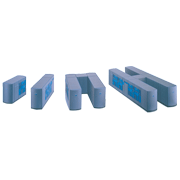Hitachi announced the SR8000 supercomputer in May 1998. The SR8000 featured Hitachi’s own RISC microprocessors developed with 0.25-micron CMOS technology and a multidimensional crossbar network that delivered high performance in several transfer patterns.
By combining the powerful performance of conventional vector-based supercomputers with the inherent scalability of parallel computers, the SR8000 could be scaled by a factor of 32, from 32 gigaFLOPS to 1024 gigaFLOPS, in terms of theoretical peak performance.
Hitachi also achieved high-speed performance on par with vector processors by using an architecture known as cooperative microprocessors in a single address space (COMPAS), which simultaneously drives multiple microprocessors making up a node at high speeds.
| Model | H4 | H8 | H16 | H32 | H64 | H128 |
|---|---|---|---|---|---|---|
| System performance (peak) |
32giga FLOPS |
64giga FLOPS |
128giga FLOPS |
256giga FLOPS |
512giga FLOPS |
1024giga FLOPS |
| No. of nodes | 4 | 8 | 16 | 32 | 64 | 128 |
| Max. main memory capacity |
32GB | 64GB | 128GB | 256GB | 512GB | 1024GB |


